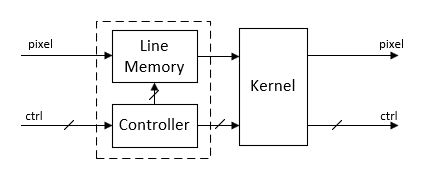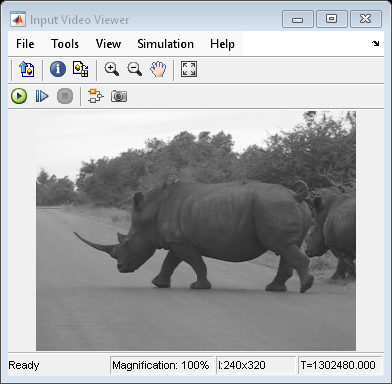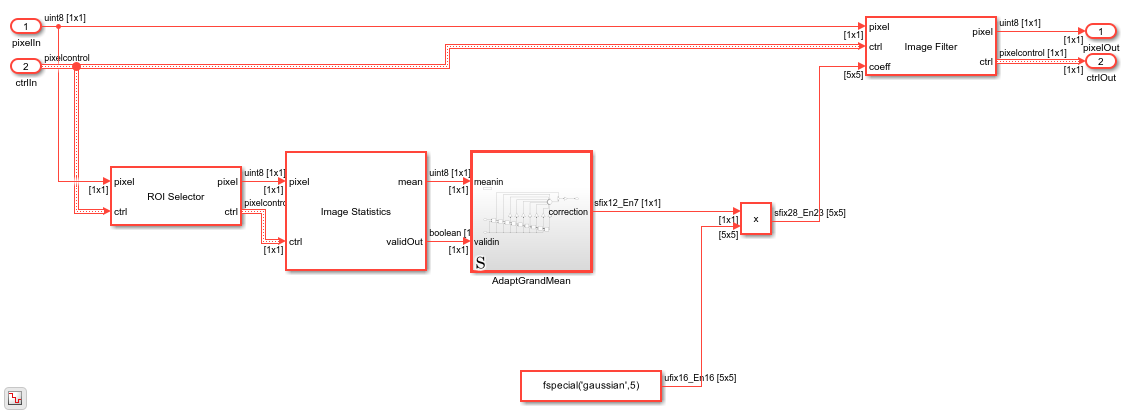Image Filter
2-D FIR filtering
Libraries:
Vision HDL Toolbox /
Filtering
Description
The Image Filter block performs two-dimensional finite impulse response (FIR) filtering on a pixel stream and supports the use of programmable filter coefficients.
Examples
Design Video Processing Algorithms for HDL in Simulink
Design a hardware-targeted image filter using Vision HDL Toolbox™ blocks.
Adapt Image Filter Coefficients from Frame to Frame
Use programmable coefficients to correct a time-varying impairment on the input video.
Filter Multipixel Video Streams
Design filters that operate on a multipixel input video stream. Use multipixel streaming to process high-resolution or high-frame-rate video with the same synthesized clock frequency as a single-pixel streaming interface. Multipixel streaming also improves simulation speed and throughput because fewer iterations are required to process each frame, while maintaining the hardware benefits of a streaming interface.
Ports
This block uses a streaming pixel interface with a bus for
frame control signals. This interface enables the block to operate independently of image size
and format. The pixel ports on this block support single pixel streaming or
multipixel streaming. Single pixel streaming accepts and returns a single pixel value each clock
cycle. Multipixel streaming accepts and returns a vector of M pixels per
clock cycle to support high-frame-rate or high-resolution formats. The M
value corresponds to the Number of pixels parameter of the Frame To
Pixels block. Along with the pixel, the block accepts and returns a
pixelcontrol bus that contains five control signals. The control signals
indicate the validity of each pixel and their location in the frame. For multipixel streaming,
one set of control signals applies to all pixels in the vector. To convert a frame (pixel
matrix) into a serial pixel stream and control signals, use the Frame
To Pixels block. For a full description of the interface, see Streaming Pixel Interface.
Input
This block supports single pixel streaming or multipixel streaming. For single pixel streaming, specify a single input pixel as a scalar intensity value. For multipixel streaming, specify a vector of two, four, or eight pixel intensity values. For details of how to set up your model for multipixel streaming, see Filter Multipixel Video Streams.
This block does not support multicomponent streaming. To process multicomponent
streams, replicate the block for each component. The pixelcontrol
bus for all components is identical, so you can connect a single bus to multiple
replicated blocks.
The software supports double and
single data types for simulation, but not for HDL code generation.
Data Types: uint | int | fixed point | double | single
The pixelcontrol bus contains five signals.
The signals describe the validity of the pixel and its location in the frame. For more
information, see Pixel Control Bus.
For multipixel streaming, each vector of pixel values has one set of control signals.
Because the vector has only one valid signal, the pixels in the
vector must be either all valid or all invalid. The hStart and
vStart signals apply to the pixel with the lowest index in the
vector. The hEnd and vEnd signals apply to the
pixel with the highest index in the vector.
Data Types: bus
Specify the filter coefficients as a 2-D matrix of numeric values. Each dimension of the matrix must have at least 2 elements, but no more than 64 elements.
The software supports double and
single data types for simulation, but not for HDL code generation.
The block samples the values from the coeff port only at the start of a frame and ignores any changes within a frame.
Dependencies
To enable this port, set the Filter coefficients source
parameter to Input port.
Data Types: int | uint | fixed point | single | double
Output
Output pixel stream, returned as a scalar value representing intensity, or as a vector of two, four, or eight pixel intensity values. The dimensions and data type of the output pixel port match the dimensions and data type of the input pixel port.
The software supports double and
single data types for simulation, but not for HDL code generation.
Data Types: uint | int | fixed point | double | single
The pixelcontrol bus contains five signals.
The signals describe the validity of the pixel and its location in the frame. For more
information, see Pixel Control Bus.
For multipixel streaming, each vector of pixel values has one set of control signals.
Because the vector has only one valid signal, the pixels in the
vector must be either all valid or all invalid. The hStart and
vStart signals apply to the pixel with the lowest index in the
vector. The hEnd and vEnd signals apply to the
pixel with the highest index in the vector.
Data Types: bus
Parameters
Main
Select the source for specifying the filter coefficients.
Property(default) — Use this value to specify filter coefficients using the Filter coefficients parameter.Input port— Use this value to specify filter coefficients through the coeff input port.
Specify the filter coefficients as a matrix. Each dimension of the matrix must have at least 2 elements, but no more than 64 elements.
Dependencies
To enable this parameter, set the Filter coefficients
source parameter to Property.
Select one of these methods for padding the boundary of the input image. For more information about these methods, see Edge Padding.
Constant— Interpret pixels outside the image frame as having a constant value.Replicate— Repeat the value of pixels at the edge of the image.Symmetric— Set the value of the padding pixels to mirror the edge of the image.Reflection— Set the value of the padding pixels to reflect around the pixel at the edge of the image.None— Exclude padding logic. The block does not set the pixels outside the image frame to any particular value. This option reduces the hardware resources used by the block and the blanking required between frames but affects the accuracy of the output pixels at the edges of the frame. To maintain pixel stream timing, the output frame is the same size as the input frame. However, to avoid using pixels calculated from undefined padding values, mask off the KernelSize/2 pixels around the edge of the frame for downstream operations. For details, see Increase Throughput by Omitting Padding.
Specify an integer to pad the boundary of the input image. The block casts this value to the same data type as the input pixel.
Dependencies
To enable this parameter, set the Padding method parameter to
Constant.
Size of the line memory buffer, specified as a positive integer. Choose a power of two that accommodates the number of active pixels in a horizontal line. If you specify a value that is not a power of two, the buffer uses the next largest power of two.
When you use multipixel input, this value must accommodate (Active pixels per line)/(Number of pixels) + 2.
The block allocates (N – 1)-by-Line buffer size memory locations to store the pixels. N represents the rows of the coefficient matrix.
Data Types
Specify a rounding method for internal fixed-point calculations.
When you clear this parameter, fixed-point and integer values wrap around to zero when the value overflows what is representable with that data type. When you select this parameter, the value saturates at the maximum representable value.
Select the method for determining the data type of the filter coefficients.
Click the Show data type assistant button to display the Data Type Assistant, which helps you set the data type of the Coefficients parameter. For details, see Specify Data Types Using Data Type Assistant (Simulink).
When converting the coefficients to the specified data type, the block rounds to the nearest representable value and saturates to the maximum value if the value exceeds the maximum value representable with the data type.
Dependencies
To enable this parameter, set the Filter coefficients
source parameter to Property.
Select the method for determining the data type of the output pixel.
Click the Show data type assistant button to display the Data Type Assistant, which helps you to set the data type of the Output parameter. For details, see Specify Data Types Using Data Type Assistant (Simulink).
Select this parameter to lock all data type settings of this block against changes by the Fixed-Point Tool and the Fixed-Point Advisor. For more information, see Lock the Output Data Type Setting (Fixed-Point Designer).
Tips
When you use a block with an internal line buffer inside an Enabled Subsystem (Simulink), the enable signal pattern must maintain the timing of the pixel stream, including the minimum blanking intervals. If the enable pattern corrupts the timing of the pixel stream, you might see partial output frames, corrupted pixel stream control signals, or mismatches between Simulink® and HDL simulation results. You may need to extend the blanking intervals to accommodate for cycles when the enable is low. For more information, see Configure Blanking Intervals.
Algorithms
The block implements the 2-D FIR filter with a fully pipelined architecture. Each multiplier has two pipeline stages on each input and two pipeline stages on each output. The adder is a pipelined tree structure. HDL code generation uses symmetric, unity, or zero-value coefficients to reduce the number of multipliers.
When you use multipixel streaming, the block uses a single line memory and implements one filter kernel for each of the M input pixels, in parallel. This increase in hardware resources is a trade off for increasing throughput compared to single-pixel streaming.
When you provide coefficients using the Filter coefficients
parameter, you can optimize the multipliers for HDL code generation by using a canonical
signed digit (CSD) representation or factored CSD representation. To use a CSD of factored CSD
representation, right-click the block, select HDL Code > HDL
Block Properties, and set the ConstMultiplierOptimization
parameter to csd or fcsd.
When you provide coefficients using the coeff port, the latency depends on the size of the filter coefficients. For an N-by-M coefficient matrix provided using the coeff port, the block generates NxM multipliers.
The latency of the block is the line buffer latency plus the
latency of the kernel calculation. The line buffer latency includes edge padding by default. The
latency of the padding operation depends on the size of the kernel. If edge padding is not
necessary for your design, you can reduce the latency by setting the Padding
method parameter to None. When you use this option, the block
latency does not depend on your kernel size. To determine the exact latency for any
configuration of the block, measure the number of time steps between the input and output
control signals.

The block shows its latency on the block mask. The latency displays as a number of lines
and pixels. The exact number of clock cycles depends on the number of pixels in a line of
your image frame and the input pixel valid pattern. Use the displayed latency information
along with the pixelcontrol bus signals to align parallel data paths in
your design.
Note
When you use edge padding, use a horizontal blanking interval of at least twice the kernel width. This interval lets the block finish processing one line before it starts processing the next one, including adding padding pixels before and after the active pixels in the line.
The horizontal blanking interval is equal to TotalPixelsPerLine – ActivePixelsPerLine or, equivalently, FrontPorch + BackPorch. Standard streaming video formats use a horizontal blanking interval of about 25% of the frame width. This interval is much larger than the filters applied to each frame.
The horizontal blanking interval must also meet these minimums:
If the kernel size is less than 4, and you use edge padding, the total porch must be at least 8 pixels.
When you disable edge padding, the horizontal blanking interval must be at least 12 cycles and is independent of the kernel size.
The BackPorch must be at least 6 pixels. This parameter is the number of inactive pixels before the first valid pixel in a frame.
For more information, see Configure Blanking Intervals.
This table shows the resource use after synthesis of the block for the Xilinx®
Zynq®-7000 SoC ZC706 Evaluation Kit with single-pixel uint8 input
and the default parameter settings. The design achieves a clock frequency of 361 MHz.
| Resource | Usage |
|---|---|
| Slice LUTs | 281 |
| Slice Registers | 535 |
| DSP48 | 0 |
| Block RAM | 0.5 |
Extended Capabilities
This block supports C/C++ code generation for Simulink accelerator and rapid accelerator modes and for DPI component generation.
HDL Coder™ provides additional configuration options that affect HDL implementation and synthesized logic.
This block has one default HDL architecture.
| ConstMultiplierOptimization | Canonical signed digit (CSD) or factored CSD optimization. The
default is |
| ConstrainedOutputPipeline | Number of registers to place at
the outputs by moving existing delays within your design. Distributed
pipelining does not redistribute these registers. The default is
|
| InputPipeline | Number of input pipeline stages
to insert in the generated code. Distributed pipelining and constrained
output pipelining can move these registers. The default is
|
| OutputPipeline | Number of output pipeline stages
to insert in the generated code. Distributed pipelining and constrained
output pipelining can move these registers. The default is
|
You cannot generate HDL code for this block if it is inside a Resettable Synchronous Subsystem (HDL Coder).
Version History
Introduced in R2015aThe block now shows its latency on the block mask. The latency displays as a number of
lines and pixels. The exact number of clock cycles depends on the number of pixels in a line
of your image frame and the input pixel valid pattern. Use the displayed latency information
along with the pixelcontrol bus signals to align parallel data paths in
your design.
The block now supports multipixel streams that have 2 pixels per clock cycle.
Pad the edge of a frame by reflecting around the edge-pixel value. This padding method helps reduce edge contrast effects and can improve results for machine learning while maintaining the original frame size.
You can now configure the block to not add padding around the boundaries of the active
frame. This option reduces the hardware resources used by the block and reduces the blanking
interval required between frames but affects the accuracy of the output pixels at the edges
of the frame. To use this option, set the Padding method parameter to
None. For an example, see Increase Throughput by Omitting Padding.
The block now supports multipixel streams. The HDL implementation replicates the algorithm for each pixel in parallel.
For multipixel streaming, the block supports input and output column vectors of 4 or 8
pixels. The ctrl port remains scalar, and the control signals in the
pixelcontrol bus apply to all pixels in the vector.
The block now allows for a coefficient kernel with up to 64-by-64 elements.
The block now accepts coefficients from an input port. Each dimension of the matrix must have at least 2 and no more than 16 elements. The block samples the values from the coeff port at the start of a frame only and ignores any changes within a frame.
In previous releases, you could specify a row vector of coefficients, that is, a matrix of 1-by-N elements. Now, the coefficient matrix must have at least 2 elements in each dimension.
The internal line buffer in this block now handles bursty data, that is, noncontiguous valid signals within a pixel line. This implementation uses fewer hardware resources due to improved padding logic and native support for kernel sizes with an even number of lines. This change affects the Line Buffer block and blocks that use an internal line buffer.
The latency of the line buffer is now reduced by a few cycles for some configurations. You might need to rebalance parallel path delays in your models. A best practice is to synchronize parallel paths in your models by using the pixel stream control signals rather than by inserting a specific number of delays.
See Also
2-D FIR
Filter (Computer Vision Toolbox) | Frame To Pixels | visionhdl.ImageFilter
MATLAB Command
You clicked a link that corresponds to this MATLAB command:
Run the command by entering it in the MATLAB Command Window. Web browsers do not support MATLAB commands.
选择网站
选择网站以获取翻译的可用内容,以及查看当地活动和优惠。根据您的位置,我们建议您选择:。
您也可以从以下列表中选择网站:
如何获得最佳网站性能
选择中国网站(中文或英文)以获得最佳网站性能。其他 MathWorks 国家/地区网站并未针对您所在位置的访问进行优化。
美洲
- América Latina (Español)
- Canada (English)
- United States (English)
欧洲
- Belgium (English)
- Denmark (English)
- Deutschland (Deutsch)
- España (Español)
- Finland (English)
- France (Français)
- Ireland (English)
- Italia (Italiano)
- Luxembourg (English)
- Netherlands (English)
- Norway (English)
- Österreich (Deutsch)
- Portugal (English)
- Sweden (English)
- Switzerland
- United Kingdom (English)

